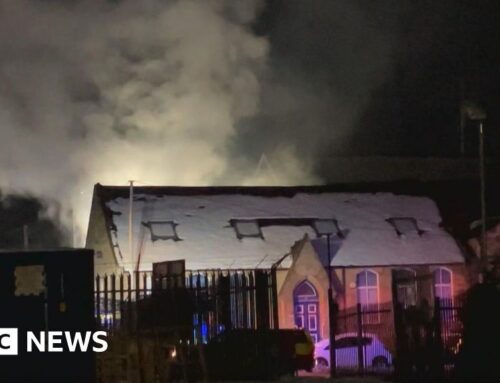Reviewing some of Michigan’s top climate, environmental issues in 2024
December 28, 2024
- THE TRAIL DOWN to the Sleeping Bear Dunes National Lakeshore in the northwestern Lower Peninsula of Michigan. (Susan J. Demas/Michigan Advance)
- A map of Enbridge’s Line 5 pipeline from Superior, Wis., through Upper and Lower Michigan to Sarnia, Ontario, Canada. (Laina G. Stebbins graphic)

THE TRAIL DOWN to the Sleeping Bear Dunes National Lakeshore in the northwestern Lower Peninsula of Michigan. (Susan J. Demas/Michigan Advance)
From continued strides in transitioning to clean energy, threats of environmental contamination and continued efforts to address health concerns stemming from pollution, 2024 brought a bevy of environmental stories within the state.
With many of the events of this year set to echo into the next, here is a look at the Michigan Advance’s top environmental stories from 2024.
Great Lakes see record low ice coverage
With states throughout the Great Lakes Region reporting their warmest winters on record, ice coverage on the Great Lakes marked its lowest level in 50 years, with an average of 4.3% ice coverage across the five lakes.
Ayumi Fujisaki-Manome, an associate researcher at the Cooperative Institute for Great Lakes Research told the Michigan Advance earlier this year that the lack of ice was due to long-term warming alongside anomalous conditions.

A map of Enbridge’s Line 5 pipeline from Superior, Wis., through Upper and Lower Michigan to Sarnia, Ontario, Canada. (Laina G. Stebbins graphic)
The warmth of last December, alongside El Nino conditions contributing to a warmer and wetter winter alongside above average air and water temperatures throughout the winter meant the conditions needed for ice did not develop, Fujisaki-Manome said.
Michigan takes steps toward first-in-the-nation nuclear plant restart
At the end of March, Secretary of Energy and former Michigan Gov. Jennifer Granholm and Gov. Gretchen Whitmer toured the Holtec Palisades Training Center before announcing the federal government’s commitment to offer a $1.5 billion conditional loan to restart the Palisades nuclear plant.
Once operational Whitmer said the southwest Michigan plant would supply power to 800,000 homes, and is expected to eliminate three million tons of CO2 from the atmosphere annually.
The restart comes as Michigan works to achieve its clean energy goals, with the state’s 2023 clean energy standard requiring a shift to 100% clean energy sources by 2040, including options for nuclear and natural gas utilizing 90% effective carbon capture technology.
However, the plant restart is not without its detractors. Ahead of the funding announcement, two community members were escorted out for protesting the plant’s restart. Additionally, a coalition of activists and nuclear watchdogs has filed to intervene with the Nuclear Regulatory Commission and requested a hearing to oppose the restart of the Palisades plant over safety and environmental concerns. Some Michigan environmental advocates also opposed the inclusion of funding for Palisades in the state budget, instead advocating for the buildout of sources like wind and solar.
States Newsroom Fellow Lucy Valeski toured the training facility over the summer, later detailing her visit and what a restart would mean for the state and the nation as the facility moves toward its expected reopening in 2025.
State forges forward as a clean energy leader
After the passage of its 100% clean energy standard, Michigan is charging ahead on clean energy, with a June report showcasing Michigan as a national leader in clean energy jobs and investments.
The report from Climate Power — a communications firm focused on building support for climate action — found Michigan had secured more than $25 billion in new investments between Aug. 16, 2022, and May 31, 2024.
According to the report 585 new clean energy projects have been announced across the nation since 2022, with Michigan securing the greatest share with 58 projects leading to the creation of 21,490 new jobs.
Michigan similarly led the nation in 2023, with another Climate Power report projecting 167,000 new clean energy jobs in the state over the next decade due to investments from the Inflation Reduction Act.
While the state works to shift to renewable energy sources, it has also launched a new office under the Department of Labor and Economic Opportunity to guide communities and industries through that transition: The Community and Worker Economic Transition Office.
Created as part of the 2023 clean energy package, the office has already begun working with labor groups, local government officials and businesses to strategize on how to retain jobs through efforts like retooling plants and supporting job training for in-demand skills needed to support the roll out of clean energy and the production of electric vehicles.
The Michigan Advance sat down with LEO Senior Chief Deputy Director Jonathan Smith at the end of May to break down what the office is doing, and its plans for the future as the state’s clean energy industry expands.
Case to shut down Line 5 returns to state court
Michigan Attorney General Dana Nessel’s case to shut down Enbridge Inc.’s Line 5 pipeline is set to resume in state court after a decision earlier this year in the Sixth Circuit Court of Appeals.
The case was initially filed in state court in 2019, where it was litigated for more than a year, but Enbridge, a multinational pipeline and energy company based in Canada, later filed a successful motion near the end of 2021 to move the case to federal court.
While Nessel filed her own motion to return the case to state court, the request was denied in 2022. However, the federal judge overseeing the case, Janet Neff, later certified the decision for interlocutory appeal, allowing the Sixth Circuit Court of Appeals to review whether the case belongs in state or federal court before it is fully litigated.
In June, the Court of Appeals determined the case should be heard in state court, later denying a request to rehear the decision.
Line 5 runs from northwest Wisconsin into Michigan’s Upper Peninsula, under the Straits of Mackinac, through the Lower Peninsula into Sarnia, Canada, transporting about 23 million gallons of crude oil and liquid natural gas daily.
Indigenous communities and environmental activists have advocated for the pipeline to be shut down, fearing a rupture in the straits could lead to a Great Lakes oil spill.
After a 2018 anchor strike dented the pipeline, furthering concerns of a spill in the Great Lakes, Enbridge proposed moving Line 5 into a concrete-lined tunnel embedded beneath straits, an effort which requires permits from the Michigan Department of Environment Great Lakes and Energy, The Michigan Public Service Commission and the U.S. Army Corps of Engineers.
While Enbridge secured permits from EGLE in early 2021, and the MPSC in 2023, the U.S. Army Corps of Engineers has extended its environmental review for the Line 5 tunnel project, with the corps now expected to issue its draft environmental impact statement in spring 2025.
The pipeline company has also agreed not to act on the permit from EGLE and must apply for a new permit to incorporate the results from new wetlands surveys.
———
Michigan Advance is part of States Newsroom, a national 501(c)(3) nonprofit. For more, go to https://michiganadvance.com.
Search
RECENT PRESS RELEASES
Related Post





